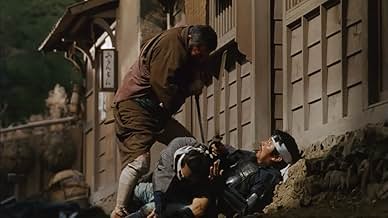Looked forward to seeing this last version by the original actor. But, aside from the color photography, violent swordsmanship, and invocations of past films, which deserve praise (if you recall the bloodless b&w films of the 60's), I really had trouble with the plot lines and trying to follow along the meandering trail of who was who, what was what, and why they were doing what they were doing.
There were a lot of characters featured here, and the connections among them were not very clear. A scar faced villain appears early on, and then shows up toward the end to complete the circle. A woman who seems to have unexplained authority seduces the hero and then drops completely from sight. A minor character shows off his remarkable skill in effecting a kill and then dies rather unexpectedly and without fanfare at the end.
The sword fighting in this movie explodes with unexpected suddenness, after long scene setting or mood setting intervals, in various parts of the film. The depiction of violence is pretty good, but some scenes are absurd, such as the one in which a leader who has donned a make shift suit of armor made up of metal coins (ryo pieces)is stabbed repeatedly and spurts blood all over, like that braggadocio knight in the first MONTY PYTHON picture.
You have to suspend your disbelief that a blind man can survive against 30 or 40 or 50 to one odds, especially in one case where the bad guys have guns. Is the hero gifted like the Marvel Comics hero Daredevil with extraordinary hearing? And extra sensory perception? Well, that is the only explanation for his survival. Or the absolute incompetence of his enemies in being able to formulate a plan of attack against him.
So many plot lines, so many unresolved issues. Zatoichi is like a tornado who comes to a village, gambles a bit, massages a bit, plays with kids, makes friends here and there, and then sweeps away many lives, leaving death and destruction, and then goes his lonely way down a dirt road. Ordinary folks may come out and cheer (as at the end of this film) for the presumed end of some oppression, but you are left wondering where were these people throughout the movie. What happens after he leaves? Finally, there is so much ethnic tradition being depicted here that many people may have a hard time understanding what is happening. So, I can't recommend this film highly -- unless a film goer has a lot of familiarity with the previous films featuring Zatoichi and can tolerate some of the problems I referred to above. Maybe the color photography may make things bright. "Painting the Clouds with Sunshine," as that old song goes. Here, though, it's blood red.

















